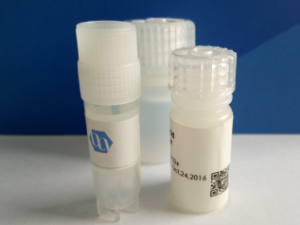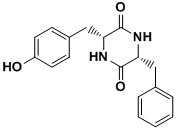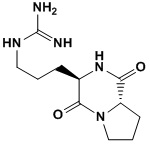$ 540.0
Quantity: 50mg
In stock
Description
Product name: Lactoferricin B
Catalog#: 1338001
Organism: Cow
Synonyms: bLfcin, Lfcin B,Lfcin B (17–41) , FKCRRWQWRMKKLGAPSITCVRRAF,
Sequence: Phe-Lys-Cys-Arg-Arg-Trp-Gln-Trp-Arg-Met-Lys-Lys-Leu-Gly-Ala-Pro-Ser-Ile-Thr-Cys-Val-Arg-Arg-Ala-Phe
Modifications: disulfide(3,20),
M.W: 3123.8
M.F.: C141H224N46O29S3
Purity: 95%
Counter ion: Trifluoacetate
Format: Lyophilized powder
Description: lactoferricin (Lfcin) was found to be produced in the human stomach, indicating that this peptide is generated in vivo for host defense. Lactoferricin is a potent antimicrobial peptide released from the N-terminal part of lactoferrin by gastric pepsin cleavage. Lactoferricin B (Lfcin B) consists of 25 amino acids corresponding to residues 17–41 from the N-terminus of bovine lactoferrin. The antibacterial activity of Lfcin is thought to involve the disordering and alteration of the permeability of the bacterial membrane, resulting in inhibition of macromolecular biosynthesis and ultimately cell death. Apart from having a broad antibacterial spectrum, bLfcin was also found to be efficacious against yeasts, such as Candida albicans, Cryptococcus uniguttulatus, C. curvatus, C. albidus and Trichosporon cutaneum. In addition to antibacterial and antifungal uses, bLfcin’s anti-catabolic and anti-inflammatory effects were recently assessed in ex vivo experiments on human articular cartilage and synovium. bLfcin demonstrated chondroprotective properties, damping the inflammatory response in synovial fibroblasts, and may thus be seen as a promising molecule in the prevention and/or treatment of degenerative joint diseases. Additionally, considering its antimicrobial activities, bLfcin may also bring therapeutic benefits to septic arthritis. bLfcin might be a promising candidate for clinical use in improving the susceptibility of biofilm to antifungals, and could also be used as an antibiofilm-antifungal additive in lens-care solutions. On the basis of its wide spectrum of activity, bLfcin is also a promising candidate as preservative in various foods and beverages.
Usage: For Scientific Research Use Only, Not for Human Use.



